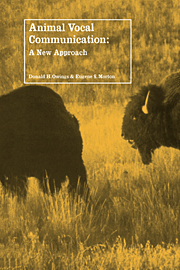Book contents
- Frontmatter
- Contents
- Preface
- Acknowledgments
- Prologue
- 1 Overview of ideas
- 2 The roles of assessment and management in communication
- 3 Form and function in vocal communication
- 4 Mechanisms and proximate processes of vocal communication
- 5 Assessment/management: a viable replacement for the information concept
- Reference
- Index
4 - Mechanisms and proximate processes of vocal communication
Published online by Cambridge University Press: 05 June 2012
- Frontmatter
- Contents
- Preface
- Acknowledgments
- Prologue
- 1 Overview of ideas
- 2 The roles of assessment and management in communication
- 3 Form and function in vocal communication
- 4 Mechanisms and proximate processes of vocal communication
- 5 Assessment/management: a viable replacement for the information concept
- Reference
- Index
Summary
This chapter is not divided as Chapter 2 is, into separate sections on assessment and management. Instead, it considers the integrated proximate functioning of these two processes, discussing the contributions of perception, cognition, motivation, and emotion to the interacting operation of assessment and management both within and between individuals. These multileveled interactions are most clearly highlighted in the last section of this chapter, in which the development of communicative abilities is explored. The adoption of an A/M approach has provided a framework for dealing with the dynamics of social interaction.
The material here may seem a bit off the point for those readers expecting a treatment dealing exclusively with vocal communication. Time is spent exploring broader issues, of how perception, cognition, motivation, and emotion work in general, not just during communication, and of how interactions between individuals not only result from management and assessment, but also influence those two processes. This latter point, that the dynamics of interaction among individuals is the arena of communication, is convergent with the same consistent theme in the writings of John Smith (1997), even though its source lies in a very different, noninformational starting point from Smith's. We share with Smith this message: if we are to continue progressing in our understanding of communication, we must return systematic descriptive research on the broader contexts of communicative behavior to its former highpriority position. With this theme, we ally ourselves once more with Tinbergen (1963), whose seminal paper on the aims and methods of ethology featured not only sections on his four questions, but also an initial section entitled ‘Observation and Description.’
- Type
- Chapter
- Information
- Animal Vocal CommunicationA New Approach, pp. 161 - 227Publisher: Cambridge University PressPrint publication year: 1998



